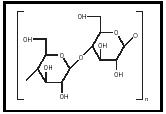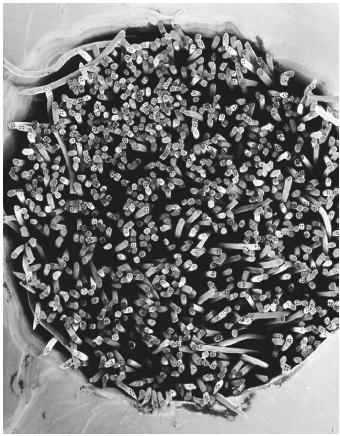Fibers

Fibers are long strands of molecules interwoven to form a linear, stringlike structure. They may be natural or made by humans and are essential to

clothing, industry, and our very bodies. Natural fibers are of plant or animal origin. In many cases, synthetic fibers mimic natural fibers.
Natural Fibers
Among the natural fibers are cellulose, the primary structural component of plants and bacterial cell walls; animal fibers such as wool and silk; and biochemical fibers. Plant fibers are composed of cellulose (see Figure 1), lignin (see Figure 2), or similar compounds; animal fibers are composed of protein (see Figure 3).
Cellulose, the most widespread organic molecule on Earth, is the major component of plant cell walls. Plants produce approximately 50 kilograms of cellulose daily for each person on Earth. A linear polymer made up of 10,000 to 15,000 glucose molecules bonded in a 1 → 4 glycosidic linkage, it is made up almost entirely of glucose. Cellulose molecules contain many polar hydroxyl groups, which allow them to interact with adjacent molecules to form fibers. These fibers are structurally strong and resistant to chemical attack, so wood products are widely used in construction and production of paper.
Cotton, a vegetable fiber that is almost pure cellulose, grew to become an important industrial commodity during the nineteenth century. Composed of cellulose strands in small springlike coils, cotton fibers have no surface scales and are softer than wool and less likely to provoke itching. First used as a textile material in India, cotton is now grown in every temperate part of the world and has been an important commodity in the southern United States. Cotton plants grow seed cases called bolls that yield tangled masses of fibers which are easily collected and spun. Processing cotton fibers is done in much the same way as wool.
Natural fibers such as cotton can be chemically modified to form rayon or acetate. Rayon was first called artificial silk. In the viscose process, cellulose is dissolved in sodium hydroxide, pushed through spinnerets, and treated with acid to harden. Treatment with copper compounds and ammonia is used to form hosiery yarns. Acetate (or cellulose acetate), produced by treating cotton with acetic acid and acetic anhydride, is also used in production of clothing.
Hemicellulose is similar in structure to cellulose, but chains of hemicellulose are shorter and less stable. Soluble hemicellulose chains attract water and form gels. Unlike cellulose, hemicellulose is a polymer of various monosaccharides, such as glucose, galactose, mannose, xylose, and arabi-nose.
Lignin polymers are often found in most plant structures in association with cellulose. The structure of lignin is not well defined, but lignin appears to be made up of polymers of propylbenzene with hydroxy and methoxy groups attached. Lignin is primarily hydrocarbon in nature and makes up a major portion of insoluble dietary fiber.
Animal Fibers. Animal hair composed of protein is a common biological fiber. Numerous types of hair have been used commercially for weaving, production of ropes, padding, and insulation.

Wool fibers are made of animal hair, principally from sheep. Each hair is a complex structure made up of layers of protein molecules. Cloth made from wool has excellent insulating properties and resists wrinkling. Wool fibers can be stretched, dyed, and woven.
For centuries, sheep have been bred for their wool-bearing qualities. Production of woolen fabrics is a highly technical process. In its simplest form, sheep are sheared and the wool sorted and cleaned, then the wool is carded to straighten the fibers, spun into thin cords, and woven into fabrics. Each step in this process has been refined to provide a high-quality product of vast commercial importance.
Silk is an animal fiber valued for its texture, strength, and luster. First prepared in ancient China, silk fabric was expensive, luxurious, and soft; its popularity led to the development of a trade route known as the Silk Road leading from Asia to Europe. Early American entrepreneurs such as Benjamin Franklin promoted the silk industry in the colonies. Silkworms spin cocoons that are collected, steamed, and unwound to obtain the silk fiber by a process known as reeling. A number of fibers are twisted together to form a thread of raw silk. Threads are combined, cleaned, stretched, dyed, and woven into fine fabrics. Silk fibers have great tensile strength and are sometimes used in cordage .
Polymers of amino acids held together by amide linkages form the primary structures of proteins. In the portion of a protein molecule shown in figure 3, the amino acids glycine, cysteine, valine, and serine are joined by amide (peptide) bonds to form a tetrapeptide segment. In addition to hair and silk, proteins are found in some important cellular substances. Some fibers are single molecules; others are combinations of molecules lying side by side and covalently cross-linked or held in place by hydrogen bonds. Collagen fibers found in tendon, bone, and skin are side-by-side assemblies of tropocollagen. Each tropocollagen molecule consists of three polypeptide chains wound into a triple helix. Separation of collagen fibers by boiling produces gelatin. Bacterial flagella, the fibrin that helps to form blood clots, and muscle fibers also fall under the heading of fibers.
In the fine structure of cells, microtubules make up fibers such as the spindle fibers that attach to centromeres of chromosomes to pull chromatids apart during mitosis and meiosis. Microtubules function in a number of cellular processes, including motility of cells and subcellular components. Micro-tubules assemble into tubulin, a substance that can change the shape of cells.

Actin and myosin fibers or filaments make possible the contraction of muscles. Actin and myosin fibers in muscle lie side by side and react chemically, sliding together and apart to shorten and lengthen in response to energy from adenosine triphosphate.
Inorganic Materials. A few inorganic materials form fibers. Fiberglass made of spun glass has excellent insulating properties. Mixed with epoxy resins, fiberglass is an important reinforcing component for use in such products as automobile bodies and boats. Steel fibers can be pressed into steel wool pads, widely used for their abrasive quality, or they can be braided or twisted into ropes.
Carbon can be treated at high temperature to form strong, light fibers that are mixed with other materials such as epoxy resin to form composites similar to those reinforced with fiberglass but lighter and stronger. Most

carbon fiber technology converts the carbon to graphite, which forms long, thin ribbons that pack together to form fibers. Carbon fibers show promise as components of composites for aircraft and autos, but the added expense has limited carbon fiber technology to production of high-quality devices such as golf clubs, fishing rods, bicycles, tennis rackets, and luxury autos. A new technique allows the formation of remarkably strong and light carbon nanofibers. These nanofibers show promise as bases for catalysts and as microconductors that may form important components of future computers.
Asbestos fibers occurring naturally in minerals such as serpentine were once valued for their insulating qualities and resistance to chemical attack. Locomotive and industrial boilers, pipes, and cargo compartments of ships were once coated with asbestos. However, there have been so many cases of workers in the asbestos industry developing respiratory illnesses such as asbestosis or mesothelioma that asbestos is no longer being used and in many places it is being removed.
Both gold and silver can be made into threads, which can be used as electrical conductors or in production of decorative fabrics. Many valuable examples of gold tapestries, carpets, or canopies for thrones exist. The durability and luster of gold undoubtedly contribute to its value.
Synthetic Fibers
Synthetic fibers are usually polyesters or polyamides. The most important synthetic fibers are dacron, nylon, orlon, and polypropylene (primarily used for upholstery).
Acrylic fibers are vinyl polymers valued for resistance to chemical and biological degradation. Acrylonitrile (or vinyl cyanide) forms a homopolymer that is used in filters and artificial wool, which is widely used in sweaters.
Condensation fibers such as nylon and polyethylene terephthalate are formed when two or more different monomers react, releasing small molecules such as water, and forming amide or ester bonds between the monomers. Nylon, first produced by DuPont in 1938, became a mainstay of the hosiery industry and is now the most widely used fiber in carpet manufacture. Polyethylene terephthalate, produced by formation of an ester bond between terephthalic acid and ethylene glycol, is by far the most widely used synthetic fiber.
Teflon, discovered accidentally by Roy Plunkett at DuPont, is formed by polymerizing tetrafluoroethene. Teflon has a low coefficient of friction and is remarkably resistant to chemical attack. The ability of Teflon to flow under pressure makes it an ideal sealant for pipe threads and vessels, and

its low coefficient of friction makes it valuable as a component of self-lubricating bearings. The molecular weight of Teflon is high, but Teflon powders can be formed into many shapes, including artificial joints for use in the human body and fibers used in clothing.
Kevlar, a polymer of aromatic amides, is several times stronger than steel, but much lighter and also fire resistant. Kevlar fibers are formed into hollow cylinders that are then woven into fabrics useful in bullet-proof vests and manufacture of automobile tires.
SEE ALSO Cellulose ; Polyesters ; Polymers, Synthetic .
Dan M. Sullivan
Bibliography
Kadolph, Sara J., and Langford, Anna L. (2001). Textiles. Upper Saddle River, NJ: Prentice Hall.
Snyder, Carl H. (1998). The Extraordinary Chemistry of Ordinary Things, 3rd edition. New York: John Wiley.
Warner, Steven B. (1995). Fiber Science. Englewood Cliffs, NJ: Prentice Hall.
Yang, H. H. (1993). Kevlar Aramid Fiber. New York: John Wiley.